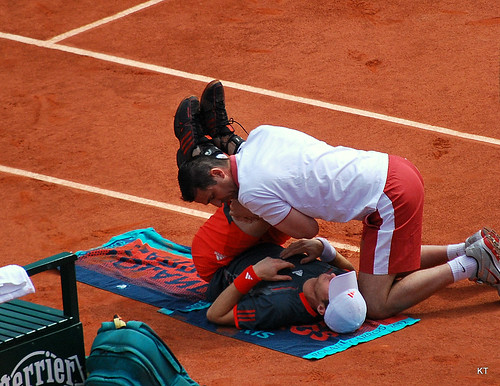 You can now add three more high-profile athletes that have recently found (or will soon find themselves) under the knife of the spine surgeon: tennis pro Andy Murray, former F1 world champion Kimi Raikkonen, and Arian Foster, running back for the Houston Texans.
You can now add three more high-profile athletes that have recently found (or will soon find themselves) under the knife of the spine surgeon: tennis pro Andy Murray, former F1 world champion Kimi Raikkonen, and Arian Foster, running back for the Houston Texans.
I am starting to get concerned that spine surgery is becoming trendy in international sport. At first, I thought it was just a reflection of the over-utilization that is witnessed in the general public in the United States. But now, "minor" spine surgery is all over the sports pages.
I have two words for these, and many other, athletes: directional preference.
If the issue of spine surgery is problematic in terms of cost and disability for the average Joe, then imagine what it does to a high level athlete who's earning potential is dependent upon his physical capacity.
Let's start with Andy Murray. The tennis pro and Wimbledon champion makes $14.9 million a year. He is not expected to play again until January, missing up to 13 tournaments along the way.
Kimi Raikkonen was the 2009 F1 World Champion. That year, his salary was $51,000,000 a year, or $2.9 million per race. This year, his salary is projected $23 million with 2 races remaining. Raikonnen will sit out those last two races. Pre-season testing will start over the winter.
And then there's the latest: Arian Foster of the Houston Texans is going to have a ruptured disc repaired. Foster makes $31,250 for each week he's on the 46-man game day roster on top of his $5.25 million base salary. It looks like the Texans won't be playoff-bound, but nonetheless, Foster will be a bystander.
Not only are these big financial concerns for three athletes, but they pose great risk for the future of each of their careers.
I will be the first to admit that little is known about the clinical presentation of all three athletes. We don't know what their symptoms were or the specifics of the onset of symptoms. We don't know if any of them were having intractable pain or worsening peripheral neurological symptoms, the two primary indicators for spinal surgery. But we do know that simply having a ruptured disc on MRI is not grounds for surgery. All published reports in the media describe these athletes as having "minor surgery", with mention of microdiscectomy if anything.
As an MDT clinician, this leaves me with a few burning questions. If a mechanical assessment (utilizing repeated movement testing) was performed by a certified McKenzie practitioner, how many of these athletes would exhibit a directional preference? My clinical experience would indicate that many, if not most, would. How many would experience centralization of their symptoms with a return of function? Same answer. And how many would be saved from their "minor" back surgery while returning them to their sport and/or training readily? Same answer.
Athletes around the world - elite and recreational, high profile and weekend warrior - that suffer from back pain, I say to you: please contact a certified MDT practitioner. Get a full mechanical assessment and let's see if you have a directional preference. It might save you money, time, and get you back onto the court, the playing field, or back on the podium far sooner than you think - no knife required.
Photo credits: carine06
 "Running Injuries: Etiology And Recovery- Based Treatment" (co-author Bridget Clark, PT) appears in the third edition and fourth editions of "Clinical Orthopaedic Rehabilitation: A Team Approach" by Charles Giangarra, MD and Robert C. Manske, PT.
"Running Injuries: Etiology And Recovery- Based Treatment" (co-author Bridget Clark, PT) appears in the third edition and fourth editions of "Clinical Orthopaedic Rehabilitation: A Team Approach" by Charles Giangarra, MD and Robert C. Manske, PT.
 Allan Besselink, PT, DPT, Ph.D., Dip.MDT has a unique voice in the world of sports, education, and health care. Read more about Allan here.
Allan Besselink, PT, DPT, Ph.D., Dip.MDT has a unique voice in the world of sports, education, and health care. Read more about Allan here.
 Top 5 finalist in three categories: "Best Overall Blog", "Best PT Blog" and "Best Advocacy Blog".
Top 5 finalist in three categories: "Best Overall Blog", "Best PT Blog" and "Best Advocacy Blog".